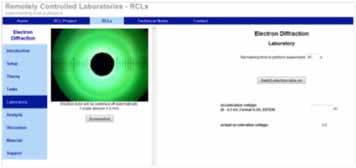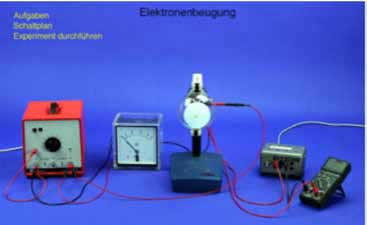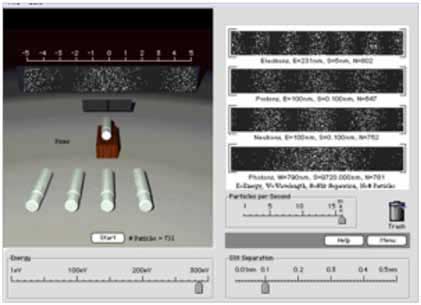Combining hands-on and virtual experiments with visualizations to teach contemporary topics to non-science students
Dean Zollman
For several years we have had a general goal of making the physics of the 20th and 21st centuries accessible to students with limited mathematical skills and little science background. We try to focus the students’ attention on why we understand things about nature and how we come to understand that rather than just what the phenomenon is. Our method is based on the well-known results of physics education research. The students need to be actively involved in their learning. Further, they should learn about conceptual models. Our approach in recent years has been to use a combination of hands-on activities, written documentation, computer visualizations, videos and analogies which we put together in an active learning package.
As an example I will describe the components of an active learning package on the study of an electron diffraction experiment. This lesson includes a program that we created ourselves and the work of several groups, including a research level experiment and a commercial film animator. All of the components are available on the Web. With the links in this article you can try it yourself.
We use electron interference as the first introduction to the wave behavior of matter.1 This approach is consistent with research that indicates students gain from a concrete experience before the introduction of the theory. It is also similar to the approach taken by Feynman.2 In this case the concrete experience is the electron diffraction experiment and the comparison of its results with those of a two-slit experiment with light. Thus, we usually begin with a look at two-slit interference patterns with light. The students look at the interference of a red light and then a green light. The critical feature is observation of the change in the interference pattern when one changes from red to green light. We do not ask the students to make measurements or calculations – just notice how the pattern changes as the wavelength changes.

Figure 1: A screen from the Kaiserslautern remote control electron diffraction experiment.

Figure 2: An interactive screen experiment for electron diffraction.

Figure 4. A diagram equivalent to a double slit experiment for electrons.

Figure 3: A screen shot from the Visual Quantum Mechanics double slit visualization. Each of the white cylinders represent a “gun” for different types of particles, electrons, protons, neutrons, photons and pions.
The physics education group at the University of Kaiserslautern has a set of experiments which can be controlled remotely. The instructions are available in both English and German, so our students can complete the experiment. Students can select the electron diffraction experiment, enter a voltage and see the interference pattern on a real electron diffraction tube. Figure 1 is a screen capture of the remote experiment. To view the electron diffraction experiment go to http://rcl.physik.uni-kl.de/, select English, then RCL from the top menu. Electron diffraction will be the first choice on the left.
For our students we have limited access to the electron diffraction apparatus. We have only two, and they are shared by several classes. Therefore, as an additional experience our students do the remote control lab and the instructors tell each student, "Do four voltages and ship them to me by email and we’ll put them all together in one class." Thus, we have a relatively large data set to look at in class.
Interactive screen experiments provide students with a way to complete virtual experiments that seem almost real. These types of experiments were developed in Germany under the name "Interaktiv Bildschirm Experimente" or IBE.3 A screen capture of an IBE for electron diffraction is shown in Figure 2. These experiments involve a large number of individual still pictures. The pictures include essentially every configuration and variable setting that the developer could think of. Students can turn on the apparatus and conduct the experiment by turning the dials. They can then record the variables and the resulting interference pattern. The IBE can sometimes be frustratingly realistic. For example, I have set it up, turned the voltage dial and nothing happens because I forgot to turn on the heater switch. (Some IBEs require students to connect the wires; this one does not.)
Once students see that an interference experiment with an electron is something interesting, we introduce some of the principles related to the phenomenon. Our approach includes having students conduct several virtual two-slit experiments with electrons and other forms of matter. Using the Visual Quantum Mechanics interactive simulation (Figure 3) we establish the relationship between the wavelength and energy of the particle. More details are presented in reference 1. You can run the two-slit experiment at http://web.phys.ksu.edu/vqm/software/online/vqm/html/doubleslit/index.html
As a summary we have the students watch an animated sequence from What the Bleep Do We Know, a commercial film with which most of our students are familiar. See http://www.whatthebleep.com. (This animated scene is not from the theatrical release of the movie. However, it is included in the extended director’s cut which is five hours long. It is also posted on the movie’s web site and YouTube, so you can avoid watching the 5-hour version.) I have my students look for errors in this scene. For example, the single slit diffraction is not treated correctly in the film. By the time we are done, most of them are able to find it. (In the film, "Dr. Quantum" mentions items that we have not yet discussed such as wave functions. I ask students to keep a list of these ideas, so that we can discuss them later.)
Another question that we address is what happens if the electrons move through the double slit apparatus one at a time. Our interactive visualization enables students to control the rate of particles. Of course, simulations can do anything, so we need to show some connection with reality. Fortunately, Tonomura, who is a research physicist for Hitachi in Japan, has done the experiment4 and put the results on the Web. A schematic diagram of his two-slit experiment for electrons is shown in Figure 4. A video of the individual electrons striking the screen and gradually building up an interference pattern is available at http://www.hitachi.com/rd/research/em/doubleslit.html and on YouTube. Once students accept that this effect is real, we start discussing difficult issues such as, "Does each electron go through one slit and then interfere (whatever that means) with another electron rather than interfere with itself?"
Returning to the visualization we repeat the experiment with electron moving through the apparatus one at a time and compare it to a similar photon experiment. However, as shown in Figure 3, several other particles are available. Each of them is based on results of research we completed while developing Visual Quantum Mechanics. In early versions we added only a nucleon so that students could investigate how the interference pattern varied with mass. However, we discovered that a common conception of students was that these particles were spreading out all of the electrons or nucleons have the same charge. Therefore, they were repelling each other. We now have protons and neutrons so that they can compare the charge dependence for particles of almost identical mass. Of course they see no such dependence.
In this example, I have shown how an instructor can start this study of the wave behavior of matter with hands-on activities, even if you do not have the apparatus. Then introduce new concepts and have the students do further applications. This is a basic learning cycle trying to build models as we go and in all of that we use a combination of different types of learning materials. These materials provide both hands-on experiences similar to doing a real experiment and visualizations that help students construct models of the physical phenomenon. Thus, by collecting all of these materials in a lesson that is consistent with physics education research, we can provide a learning experience on a rather abstract topic.
The KSU portion of the work described here has been supported by the National Science Foundation.
References
1. D. A. Zollman, N. S. Rebello, and K. Hogg,AmericanJournal of Physics 70, 252-259 (2002).
2. Richard P. Feynman, Robert B. Leighton and Matthew Sands, The Feynman Lectures on Physics Volume 3, Reading, Mass., Addison-Wesley Pub. Co. (1965) pages 1-2 to 1-9.
3. Jürgen Kirstein. Interaktiver Bildschirmexperimente (IBE) http://www.physikalische-praktika.de/dpgschule/2000/Programm/ Abstracts/kirstein
4. A. Tonomura, J. Endo,T. Matsuda,T. Kawasaki, and H. Ezawa, AmericanJournal of Physics 57 117-120 (1989).
Dean Zollman is William & Joan Porter University Distinguished Professor and Head of Physics at Kansas State University. He was the AAPT Millikan Medalist in 1995, Carnegie National Professor of the Year in 1996, and NSF Distinguished Teaching Scholar in 2004. He has conducted research in physics education since 1972.
Disclaimer- The articles and opinion pieces found in this issue of the APS Forum on Education Newsletter are not peer refereed and represent solely the views of the authors and not necessarily the views of the APS.
